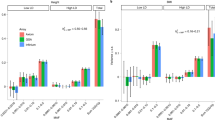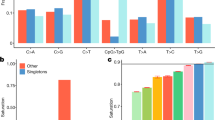Abstract
Humans show great variation in phenotypic traits such as height, eye color and susceptibility to disease. Genomic DNA sequence differences among individuals are responsible for the inherited components of these complex traits. Reports suggest that intermediate and large-scale DNA copy number and structural variations are prevalent enough to be an important source of genetic variation between individuals1,2,3,4,5,6,7,8. Because association studies to identify genomic loci associated with particular phenotypic traits have focused primarily on genotyping SNPs, it is important to determine whether common structural polymorphisms are in linkage disequilibrium with common SNPs, and thus can be assessed indirectly in SNP-based studies. Here we examine 100 deletion polymorphisms ranging from 70 bp to 7 kb. We show that common deletions and SNPs ascertained with similar criteria have essentially the same distribution of linkage disequilibrium with surrounding SNPs, indicating that these polymorphisms may share evolutionary history and that most deletion polymorphisms are effectively assayed by proxy in SNP-based association studies.
This is a preview of subscription content, access via your institution
Access options
Subscribe to this journal
Receive 12 print issues and online access
$209.00 per year
only $17.42 per issue
Buy this article
- Purchase on Springer Link
- Instant access to full article PDF
Prices may be subject to local taxes which are calculated during checkout



Similar content being viewed by others
References
Tuzun, E. et al. Fine-scale structural variation of the human genome. Nat. Genet. 37, 727–732 (2005).
Sharp, A.J. et al. Segmental duplications and copy-number variation in the human genome. Am. J. Hum. Genet. 77, 78–88 (2005).
Stefansson, H. et al. A common inversion under selection in Europeans. Nat. Genet. 37, 129–137 (2005).
Singleton, A.B. et al. α-Synuclein locus triplication causes Parkinson's disease. Science 302, 841 (2003).
Sebat, J. et al. Large-scale copy number polymorphism in the human genome. Science 305, 525–528 (2004).
Iafrate, A.J. et al. Detection of large-scale variation in the human genome. Nat. Genet. 36, 949–951 (2004).
Gonzalez, E. et al. The influence of CCL3L1 gene-containing segmental duplications on HIV-1/AIDS susceptibility. Science 307, 1434–1440 (2005).
Dhami, P. et al. Exon array CGH: detection of copy-number changes at the resolution of individual exons in the human genome. Am. J. Hum. Genet. 76, 750–762 (2005).
Cargill, M. et al. Characterization of single-nucleotide polymorphisms in coding regions of human genes. Nat. Genet. 22, 231–238 (1999).
Halushka, M.K. et al. Patterns of single-nucleotide polymorphisms in candidate genes for blood-pressure homeostasis. Nat. Genet. 22, 239–247 (1999).
Wang, D.G. et al. Large-scale identification, mapping, and genotyping of single-nucleotide polymorphisms in the human genome. Science 280, 1077–1082 (1998).
Bhangale, T.R., Rieder, M.J., Livingston, R.J. & Nickerson, D.A. Comprehensive identification and characterization of diallelic insertion-deletion polymorphisms in 330 human candidate genes. Hum. Mol. Genet. 14, 59–69 (2005).
Burn, J., Wilson, D. & Cross, I. The clinical significance of 22q11.2 deletion. in Developmental Mechanisms of Heart Disease (eds. Clark, E.B., Markwald, R.R. & Takao, A.) 559–567 (Futura, New York, 1995).
Goodship, J., Cross, I., Liling, J. & Wren, C. A population study of chromosome 22q11 deletions in infancy. Arch. Dis. Child. 79, 348–351 (1998).
Liling, J. et al. Frequency and predictive value of 22q11 deletion. J. Med. Genet. 36, 794–795 (1999).
Tezenas Du Montcel, S., Mendizabai, H., Ayme, S., Levy, A. & Philip, N. Prevalence of 22q11 microdeletion. J. Med. Genet. 33, 719 (1996).
Higgs, D.R., Old, J.M., Pressley, L., Clegg, J.B. & Weatherall, D.J. A novel α-globin gene arrangement in man. Nature 284, 632–635 (1980).
Lauer, J., Shen, C.K. & Maniatis, T. The chromosomal arrangement of human α-like globin genes: sequence homology and α-globin gene deletions. Cell 20, 119–130 (1980).
Greenberg, F. Williams syndrome professional symposium. Am. J. Med. Genet. 6 (Suppl.), 85–88 (1990).
Nelis, E. et al. Estimation of the mutation frequencies in Charcot-Marie-Tooth disease type 1 and hereditary neuropathy with liability to pressure palsies: a European collaborative study. Eur. J. Hum. Genet. 4, 25–33 (1996).
Inoue, K. & Lupski, J.R. Molecular mechanisms for genomic disorders. Annu. Rev. Genomics Hum. Genet. 3, 199–242 (2002).
Conrad, D.F., Andrews, T.D., Carter, N.P., Hurles, M.E. & Pritchard, J.K. A high-resolution survey of deletion polymorphism in the human genome. Nat. Genet., advance online publication 4 December 2005 (10.1038/ng1697).
McCarroll, S.A. et al. Common deletion polymorphisms in the human genome. Nat. Genet., advance online publication 4 December 2005 (10.1038/ng1696).
Collins, F.S., Brooks, L.D. & Chakravarti, A.A. DNA polymorphism discovery resource for research on human genetic variation. Genome Res. 8, 1229–1231 (1998).
Patil, N. et al. Blocks of limited haplotype diversity revealed by high-resolution scanning of human chromosome 21. Science 294, 1719–1723 (2001).
Frazer, K.A. et al. Genomic DNA insertions and deletions occur frequently between humans and nonhuman primates. Genome Res. 13, 341–346 (2003).
Bailey, J.A. et al. Recent segmental duplications in the human genome. Science 297, 1003–1007 (2002).
Hinds, D.A. et al. Whole-genome patterns of common DNA variation in three human populations. Science 307, 1072–1079 (2005).
Shaw, C.J. & Lupski, J.R. Implications of human genome architecture for rearrangement-based disorders: the genomic basis of disease. Hum. Mol. Genet. 13, R57–64 (2004).
Weir, B.S. Genetic Data Analysis II (Sinauer, Sunderland, Massachusetts, 1996).
Acknowledgements
We thank D. Cox for discussions and comments on the manuscript.
Author information
Authors and Affiliations
Corresponding author
Ethics declarations
Competing interests
The authors declare no competing financial interests.
Supplementary information
Supplementary Table 1
Deletion chromosomal positions, frequencies and PCR primer sequnces. (XLS 43 kb)
Supplementary Table 2
Deletion genotypes for individuals in the Discovery Panel. (XLS 53 kb)
Supplementary Table 3
Deletion genotype for African American individuals in the Diversity Panel. (XLS 130 kb)
Rights and permissions
About this article
Cite this article
Hinds, D., Kloek, A., Jen, M. et al. Common deletions and SNPs are in linkage disequilibrium in the human genome. Nat Genet 38, 82–85 (2006). https://doi.org/10.1038/ng1695
Received:
Accepted:
Published:
Issue Date:
DOI: https://doi.org/10.1038/ng1695
This article is cited by
-
Assessment of linkage disequilibrium patterns between structural variants and single nucleotide polymorphisms in three commercial chicken populations
BMC Genomics (2022)
-
A map of copy number variations in the Tunisian population: a valuable tool for medical genomics in North Africa
npj Genomic Medicine (2021)
-
Prioritization of schizophrenia risk genes from GWAS results by integrating multi-omics data
Translational Psychiatry (2021)
-
Functional and population genetic features of copy number variations in two dairy cattle populations
BMC Genomics (2020)
-
Copy number variation is highly correlated with differential gene expression: a pan-cancer study
BMC Medical Genetics (2019)



